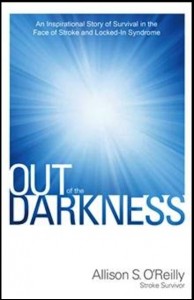 Imagine lying there, unmoving, totally paralyzed—and your only way of telling people “I’m not dead. I’m still here!” is the blink of your eyes. You can feel all sensations. You can feel every touch on your body but are unable to move. LIS is very rare and occurs in 1% of strokes.
Imagine lying there, unmoving, totally paralyzed—and your only way of telling people “I’m not dead. I’m still here!” is the blink of your eyes. You can feel all sensations. You can feel every touch on your body but are unable to move. LIS is very rare and occurs in 1% of strokes.
If you know someone is locked-in, talk to them to keep their mind stimulated. Explain what has happened, their daily schedule, how to answer and form your conversation in the form of a question. This way, the patient can blink one for yes and twice for no. Don’t talk about them as they can hear you and usually understand what is going on.
Being locked-in is immediate and occurs with a brain stem stroke. The brain stem maintains breathing, houses the cranial nerves, and contains nerve pathways that connect your upper brain to the spinal cord.
Individuals with LIS are conscious and can think and reason, but are unable to speak or move. This leaves individuals completely mute and paralyzed.
Persons with LIS can communicate using a communications board via an alphabetical code. My speech therapist at MNRH introduced me to communications board to use. A person goes up, down, and across the columns with the alphabet, and the patient blinks at the right letter. The letters form a word or word as a way to communicate—not the easiest, and patience is required. A book was also created a book of visuals of commonly used items to point to as well.
LIS is often mistaken as being in a vegetative state, which is when people can open their eyes but are not aware of their environment. In locked-in syndrome, the person is fully aware of their environment, but cannot talk or move. In truth, you look different, have an empty look, and can’t do anything, but you are still the same person inside.
It is a lot for the family to handle, even more for the patient. Rehab, rehab, rehab is most important. Even though the patient can’t do a lot, they need the rehab. You are doing what’s best for the patient. Could you do it? You might be scared, but you have to be strong for the patient.
 I am so focused on getting out the word on stroke to make something good come from something so terrible. A stroke affects everyone (spouse, family, friends) and you are at a loss of what to do when tragedy strikes. My book details things that we found helpful. Why re-create the wheel? People are overwhelmed with grief, but you need to be strong for the survivor.
I am so focused on getting out the word on stroke to make something good come from something so terrible. A stroke affects everyone (spouse, family, friends) and you are at a loss of what to do when tragedy strikes. My book details things that we found helpful. Why re-create the wheel? People are overwhelmed with grief, but you need to be strong for the survivor.
